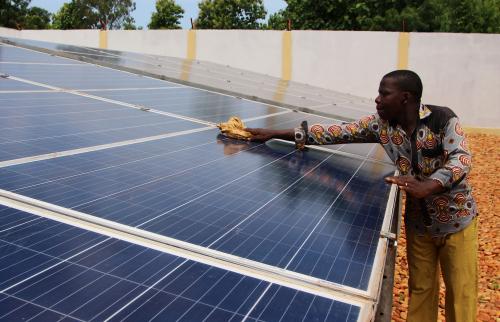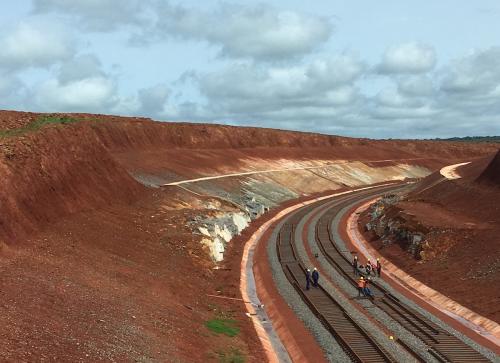Despite the widespread adoption of and progress toward the Sustainable Development Goals, Africa continues to lag behind most of the world when it comes to socioeconomic development. In fact, a recent report by the Sustainable Development Goals Center for Africa—”Africa 2030: Sustainable Development Goals Three-Year Reality Check”—reveals that minimal progress has been made and, in some instances, there is complete stagnation. More than half of the global poor (those who earn under $1.90 PPP per day) are found in Africa. One in three Africans is at the risk of food insecurity.
With 11 1/2 years to go, Africa is relatively on track to meet three goals: SDG 5 (gender equality), SDG 13 (climate action), and SDG 15 (life on land). In fact, the SDG Center’s forecasts (for the SDGs for which we have sufficient data: poverty, malnutrition, maternal mortality, net school enrollment, access to electricity, and access to drinking water) show that all African regions except North Africa are unlikely to meet the SDGs. The struggle is more pronounced for Central Africa across all the goals.
Economic growth and human development gaps
The region’s growth over the SDG period been well below the SDG target of 7 percent per year and also below the historical long-term average. In 2016—the year after the adoption of the SDGs—the sub-Saharan African region’s growth dropped to 1.4 percent. Globalization (migration, trade, and finance) has been under pressure or even reversing; China’s growth, which historically has been positively correlated with Africa’s, has decelerated in recent years; global trade growth has also dwindled; commodity prices remain depressed; and climatic conditions remain unfavorable. At the same time, social inclusion continues to be outstripped by population growth, impeding structural transformation and future productivity. Twenty-eight African countries are categorized as low income and 37 as having low human development.
A child born in Africa today is still at risk of not receiving a full, high-quality education or decent health care. An African child in school today continues to struggle to read and write due to poor quality of education services. Too many Africans continue not to visit the hospital due to lack of money. In fact, 22 African countries have a Human Capital Index score of less than 0.4. In other words, a child born today in those countries will be only 40 percent as productive at 18 years of age as one who completes their education and enjoys full health.
Data gaps persist
While we do have a snapshot of the progress Africa (and the world) is making towards achieving the SDGs, a holistic review of SDGs over the last three years was not possible given that not enough data exists. In fact, only 96 indicators have data (41.4 percent of the global indicator framework). Where data exists, it is not comprehensive and consistent. Too often, African countries do not possess updated data for crucial indicators in poverty, health, nutrition, education, and infrastructure. Household surveys are irregular: Their scope, comprehensiveness, quantity, and quality vary wildly. At the continental level, there is just not enough data for tracking SDGs 10, 11, and 12.
Challenges to governance in achieving the SDGs
The challenges inherent in the Global SDG framework require attention—now more than ever. Notably, the governance framework for the SDGs hangs largely at the international political level and has not cascaded down to national implementation frameworks. A lack of clarity around ratification, reporting, accountability mechanisms, and roles and responsibilities persists. The existing mechanisms of reporting—the Voluntary National Review in particular, to which notably only 19 African countries have reported by the end of 2018)—are not comprehensive, encourage selective goal reporting, and too often are not of the same standard, compromising comparability.
Financing the Sustainable Development Goals in Africa is getting harder
Globally, financing for the SDGs remains below the requisite investment needs. The same is true for Africa. Despite an annual total financing mix of $650 billion ($500 billion in domestic revenue, $50 billion from official development assistance, slightly less than $50 billion in foreign direct investment, and $60 billion in remittances), the estimated additional annual financing required is between $500 billion and $1.2 trillion. Already, one in five African countries does not raise enough in revenues to meet its basic state functions. Even worse, in sub-Saharan Africa, that number is one in three.
Notably, national development banks (NDBs) are a main source of long-term credit in many middle-income countries and developed economies. While Africa has 140 NDBs, they remain hugely constrained due to regulation, governance, and financing. As such, the size of most NDBs in Africa is small compared to the size of the economy in their respective countries (see selected examples in Table 1).
Table 1: Share of total assets to GDP of selected national development banks (USD millions)
Source: CDB, KDB, KfW, (Musacchio et al., 2017) DBS 2017, DBE 2016 & UDB 2017, compiled from audited financial statements.
Other sources of financing are unreliable as well. Official development assistance is failing in per capita terms, and OECD countries continue not to meet their SDG commitments of 0.7 percent of GDP. In fact, on average, they are currently meeting less than half of that goal. Foreign direct investment is, as a whole, unpredictable, but also seems to be stagnating. On the plus side, remittances are growing, but their associated costs remain over twice the SDG target of 3 percent.
Consequently, African debt is rising. The number of African countries at high risk or in debt distress has more than doubled from eight in 2013 to 18 in 2018. Close to 40 percent of sub-Saharan African countries are at risk of a major debt crisis.
There are global repercussions for not achieving the SDGs in Africa
Overall, we cannot postpone investment in human capital and people or we risk losing a generation. SDG-tailored investment vehicles must be put in place on the continent that will consider the urgency, magnitude, and complexity of challenges faced in Africa, as well as the opportunities to be seized here. Africa’s failure to attain the SDGs will have implications everywhere on the planet, since some SDGs possess a transboundary nature, for example climate change, life below water, and effective partnerships.
Note: This blog reflects the views of the authors only and does not reflect the views of the Africa Growth Initiative.





Commentary
Africa and the Sustainable Development Goals: A long way to go
July 29, 2019